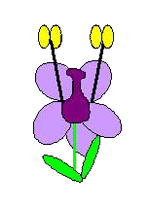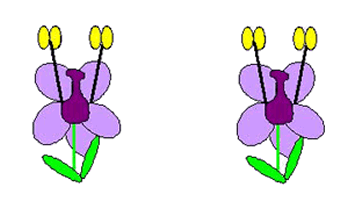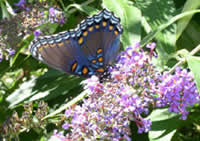USDA Forest Service Celebrating Wildflowers
|
|
|
The Birds and the Bees
Sexual StrategiesSeed production for angiosperms begins with the flowering parts. Flowers must be pollinated in order to produce seeds and fruit. Self-pollinating species can reproduce even if animal pollinators are not present. However, reproduction through self-pollination reduces genetic diversity. Self-pollinationThe anther opens and the pollen lands on the stigma of the same flower. To promote cross-pollination and increase genetic diversity, plants have evolved a wide variety of sexual strategies to attract pollinators and spread pollen from one flower to another of the same species.
Cross-pollinationAnthers open on one flower and a vector (insects, wind, or animals) moves pollen to the stigma of another flower. Pollinators may visit several flowers on one plant or may visit several flowers of the same species on a few different plants Some plants have evolved to have self-incompatibility mechanisms to avoid self-pollination. A physiological barrier makes it difficult or impossible for a flower to fertilize itself even though it may have been abundantly pollinated with its own pollen. To learn more about plant breeding mechanisms visit the Self-Incompatibility: How Plants Avoid Inbreeding web page on the Kimball's Biology Pages website.
Why do pollinators visit flowers?Insect and other animal pollinators obtain food in the form of energy-rich nectar and/or protein-rich pollen, from the flowers they visit and in return, the flowers receive the services of pollinators carrying pollen from one flower to another. While food is often a sufficient lure for pollinators, flowering plants also attract pollinators using a combination of petal shapes, scents, and colors. Pollination syndromes have been described to depict the attraction of certain types, shapes, colors, and fragrances of flowers to a range of pollinators. To learn more, examine the Pollination Syndromes web page and the Trait Table. Specialized PollinationThere are many examples of specialized plant and pollinator relationships in which flowers and insects have adapted to one another to accomplish mutually beneficial goals. These are a solid example of co-evolution. To learn more about these important interrelationships visit the CoEvolution Institute website. Some orchids have evolved ingenious ways to lure pollinators by developing flowers that appear to be female insects. Using sight and/or scent, these flowers resemble female insects so convincingly that males of the same species will attempt to copulate with the flower, inadvertently picking up pollen before visiting another female-mimicking flower. |
|
| NOTE: PDF format links require the Adobe Acrobat Reader to view. | |
| top | Disclaimers | FOIA | Privacy Policy | Quality of Information | Photo Credits & Use |
Location: http://www.fs.fed.us/wildflowers/pollinators/birdsandbees.shtml
Last modified: Tuesday, 20-May-2008 15:56:10 EDT




